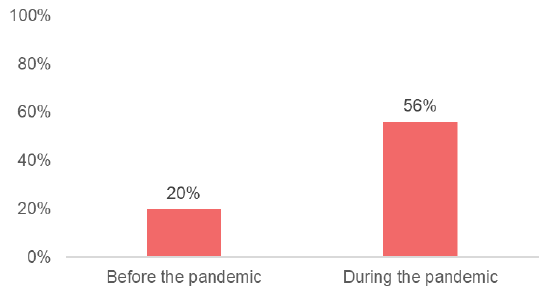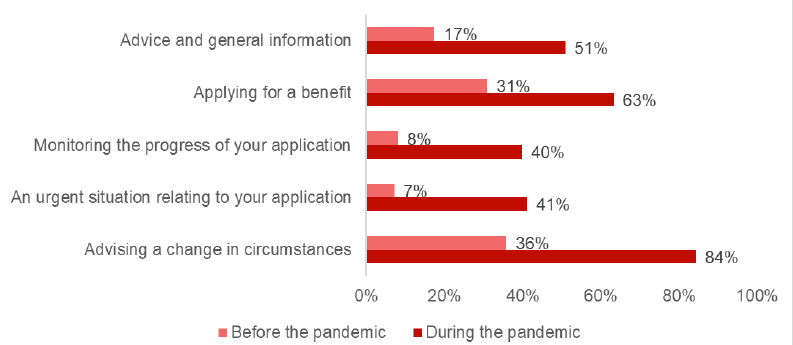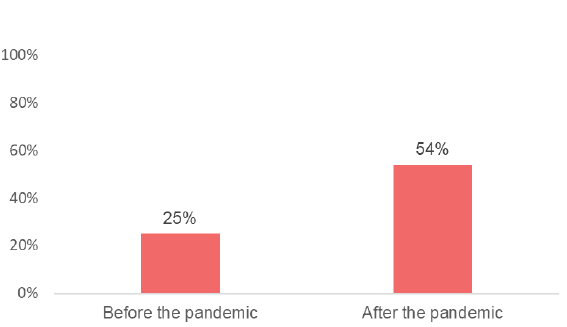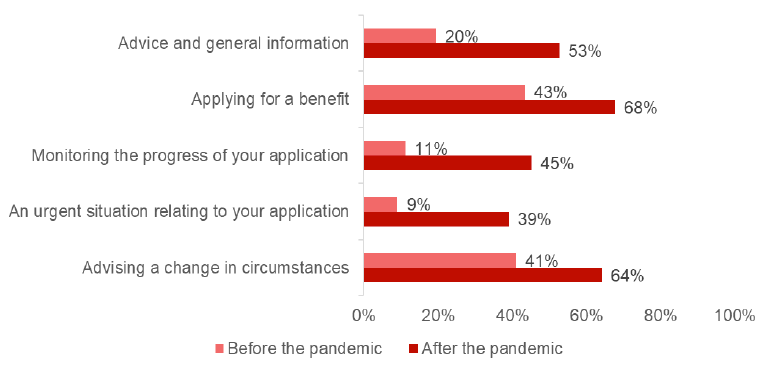Social Security client and experience panels research: effects of the coronavirus pandemic on communication preferences
A report of findings from research with client and experience panels about communication preferences.
This document is part of a collection
Changes in communication preferences during and after the pandemic
The majority of survey respondents said their preferences would stay the same during and after the pandemic. Similarly, some interview participants said that their preferences had not been affected by the pandemic and were likely to remain unchanged. Some said this was because they were used to using online communication before the pandemic and this had continued throughout. Some respondents said that they had infrequent contact with Social Security Scotland so their preferences were unchanged during the pandemic.
"I used internet a lot before the pandemic, so for me it's the same." (interview participant)
"I don't contact Social Security Scotland much, about once per year, so not felt impact." (interview participant with experience of Best Start Grant/Foods)
"Communication with Social Security [Scotland] hasn't really changed, even before the pandemic it was always through letters and is still through letters. Like notifications when the payment is coming in, it's always through the post so that hasn't changed." (interview participant with experience of Carer's Allowance Supplement)
This remainder of this chapter looks at the preferences of survey respondents who indicated a change during or after the pandemic.
Changes during the pandemic
Table 6.1 shows that around a quarter (23 per cent) of respondents said that their preferred way to get in touch would be different if they had to contact Social Security Scotland during the pandemic.
| % | |
|---|---|
| No | 64.6 |
| Yes | 22.9 |
| I'm not sure | 12.5 |
| Total | 100 |
There were some differences between respondents who said their preferences would change based on demographic characteristics. Results for different groups can be found in Table 6.2.
| Proportion saying their preferences would be different during the pandemic(%) | |
|---|---|
| Age | |
| 25-44 (n=85) | 11.8 |
| 45-59 (n=185) | 20.0 |
| 60-79 (n=119) | 34.5 |
| Disability status | |
| Long-term health condition or disability (n=318) | 24.8 |
| No Long-term health condition or disability (n=88) | 10.2 |
Older respondents were more likely to say they would change their preferences during the pandemic. Over a third (35 per cent) of respondents aged between 60 and 79 said their preferences would be different. This is compared to only 12 per cent of respondents aged between 25 and 44.
A quarter (25 per cent) of respondents with a long-term health condition or disability said their preferences would be different during the pandemic. Only 10 per cent of respondents who don't have a health condition or disability said their preferences would change.
Respondents who completed the survey in January were more likely to say their preferences would change during the pandemic. In keeping with the overall result for the question, around a quarter (25 per cent) of respondents who completed the survey in January said their preferences would change. Among those who completed the survey at the end of February or in March, only between 4 per cent and 18 per cent indicated a change. The shifting nature of the pandemic, roll out of the vaccination programme and timetable for easing restrictions may have affected how respondents thought about their preferences. Experience Panels respondents completed the survey earlier in the research period compared to Client Panels respondents. Differences in the make-up of the two groups, such as benefit experience, may also have contributed to this difference.
Changes after the pandemic
Compared to before the pandemic, a fifth of respondents (20 per cent) said their preferences would change once the pandemic was no longer a serious risk to public health (Table 6.3).
| % | |
|---|---|
| No | 66.9 |
| Yes | 19.5 |
| I'm not sure | 13.6 |
| Total | 100 |
There were some differences between respondents who said their preferences would change based on demographic characteristics. Results for different groups can be found in Table 6.4.
| Proportion saying their preferences would be different during the pandemic(%) | |
|---|---|
| Age | |
| 25-44 (n=86) | 14.0 |
| 45-59 (n=185) | 16.2 |
| 60-79 (n=116) | 25.0 |
| Disability status | |
| Long-term health condition or disability (n=316) | 19.6 |
| No Long-term health condition or disability (n=88) | 12.5 |
Older respondents were more likely to say their preferences would change after the pandemic. A quarter (25 per cent) of respondents aged between 60 and 79 indicated a change, compared to 14 per cent of respondents aged under 44. Participants with a long-term health condition or disability were more likely to say there would be a change in their preferences. A fifth (20 per cent) indicated a change compared to 13 per cent of respondents without a long-term health condition or disability.
Respondents who completed the survey earlier in the year were more likely to say their preferences would change after the pandemic. Around a quarter (25 per cent) of respondents who completed the survey in January said their preferences would change. Only 12 per cent of those who completed the survey in March indicated a change.
Increasing preferences for online communication
Those who indicated a change during or after the pandemic said they would prefer more online communication.
During the pandemic
Online methods of communication were available to choose for all purposes except challenging a decision. Among those who indicated a change during the pandemic, there was an increase in preferences for online forms, web chat, social media, and video call (Figure 6.1).

Over half (56 per cent) of choices by those who indicated a change during the pandemic were for online methods. This was up from 20 per cent before the pandemic.
Among respondents who indicated a change during the pandemic, preferences for online methods more than doubled for all relevant purposes. Figure 6.2 shows the increase in preferences for online methods for each purpose.

More than half of respondents who said their preferences would change during the pandemic now chose online methods for: advice and information (51 per cent); making an application (63 per cent); and advising a change in circumstances (84 per cent).
After the pandemic
Those who indicated a change after the pandemic also chose more online methods (Figure 6.3).

Over half (54 per cent) of choices by those who indicated a change after the pandemic were for online methods. This was up from 25 per cent before the pandemic. Figure 6.4 shows the increase in online communication for different purposes.

There were large increases for all purposes. Over half of respondents who made a change now chose online methods for: advice and information (53 per cent); making an application (68 per cent); and advising a change in circumstances (64 per cent).
Some participants said they gained experience and confidence communicating online during the pandemic. Some said that many services had moved online due to restrictions which limited in-person interactions. Some participants said that they had been shielding at home due to health concerns. They said that online communication was a safe and convenient way to communicate while this was the case.
"I've been using online communication for a while but since the pandemic lots of things have moved to be online and it suits me so much better. I do everything from my phone which is like my mini computer." (interview participant)
"A lot of it online chat or videos now rather than going to places. More on email, being emailed things and filling them in and sending them back." (interview participant)
"I am shielding and would want to do most things digitally." (survey respondent)
"More appointments with people are online. I live in north Scotland and this makes things much easier for me." (survey respondent)
After the pandemic, some respondents said that they would be happy to continue communicating online. Some noted that their experience during the pandemic had increased their confidence. Others said that they had become used to communicating online.
"I have become more comfortable with online web-chat and video calls." (survey respondent)
"I think like many people I've become accustomed to the lack of personal contact, I can touch type and I'm tech savvy so online forms and web chats are fine for me." (survey respondent)
Some said that the pandemic had shown how effective online communication could be. Comments said these advantages should not be forgotten after the pandemic. Some highlighted that video calls could replace in-person interactions or that online communication may become standard after the pandemic.
"Since the pandemic general working practices have had to adapt but in doing so they are now more user friendly for those of us with a disability. So should all options be available post pandemic. I see no reason to revert to telephone, face-to-face and postal services as the only way to do business of any kind." (survey respondent)
"The internet has been shown that it is extremely useful as meetings have taken place via Zoom for example and as such people did not need to travel.
So even if and when we get to the end of this pandemic I think it will be a very different world as it is clear that people don't need to travel miles for a meeting." (survey respondent)
"Methods of contact would revert to normal, or begin the new normal by using computerised methods of contact." (survey respondent)
One interview participant said he was looking forward to communicating online again once his local library reopened. The participant said without internet access at home, he had switched from communicating online to using the phone during the pandemic. Once restrictions were eased to allow his local library to reopen, he planned to resume his online activities.
Some participants without online access at home said they would were unlikely to be part of the trend towards more online communication after the pandemic. These participants said that options for communication should continue to take into account that not everyone has access to the internet. These participants said a change was unlikely, especially a permanent change to include more online communication.
"Online portals, video conferencing apps, they are fine for those who have access to the technology and can afford both the equipment and pay for a broadband connection as well. I, for example use a hot spot attached to my mobile, which was sufficient pre-pandemic, but struggles with the speed needed for video conferencing.
Many did not have access to these technologies in their homes, and publicly accessible computers (such as those in libraries) are either severely limited, or completely closed off all together." (survey respondent)
"Everything has to be done online. What if you can't afford internet access or don't own a smartphone? People in the area I live in are struggling to eat so internet access isn't a priority and their only other way to access the internet is through the library services and they're all closed." (survey respondent)
"I think that the COVID-19 crisis has highlighted the digital divide, and that has to be addressed. Lots of people simply don't have internet access, or call credit to make telephone calls." (survey respondent)
Others noted that they were less comfortable communicating online compared to other methods. Some respondents said this was because their disability, health condition or age could make online communication difficult.
"Having the availability of an in person customer-facing office is important. I have hearing and speech issues and talking face-to-face is easier, clearer and more accurate for both myself and the operator. Not everyone can freely access online or phone." (survey respondent)
"Online communications are difficult and off putting for older people who are not familiar or comfortable with modern technology." (survey respondent)
"You are not able to put your point over on a video stream as us older people are not used to working video link usually phone or letter." (survey respondent)
Contact
There is a problem
Thanks for your feedback